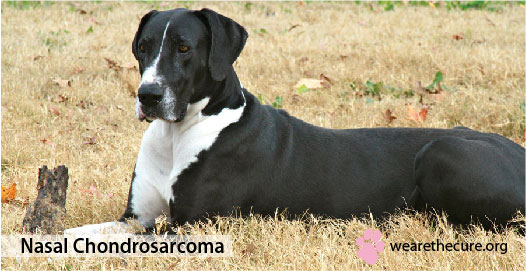Nasal Chondrosarcoma
 Description– Nasal and paranasal sinus tumors account for only 1-2% of all canine tumors. But they approximately represent 60-80% of all canine respiratory tract tumors. Normally, nasal tumors occur in the nasal cavity with secondary extension into the frontal (they are air-filled cavities lying between the lamina of the frontal bone) and other paranasal sinuses (they are air-filled spaces, communicating with the nasal cavity, within the bones of the skull and face). Although most of the nasal tumors are malignant in nature, there are reports of only 10% metastasis. Like most cancers, their cause is not known. Young dogs are over represented in nasal chondrosarcomas. However, no sex predilection has been noted.
Description– Nasal and paranasal sinus tumors account for only 1-2% of all canine tumors. But they approximately represent 60-80% of all canine respiratory tract tumors. Normally, nasal tumors occur in the nasal cavity with secondary extension into the frontal (they are air-filled cavities lying between the lamina of the frontal bone) and other paranasal sinuses (they are air-filled spaces, communicating with the nasal cavity, within the bones of the skull and face). Although most of the nasal tumors are malignant in nature, there are reports of only 10% metastasis. Like most cancers, their cause is not known. Young dogs are over represented in nasal chondrosarcomas. However, no sex predilection has been noted.
Symptoms– The clinical signs include abnormal nasal discharge, epistaxis (bleeding from the nose), epiphora (overflow of tears onto the face), bizarre sneezing (may be 10-12 times in a row), halitosis (bad breath), anorexia (symptom of poor appetite), facial deformity, exophthalmia (bulging eye) and seizures (secondary to aggressive tumors invading the brain).
Diagnostic techniques– The routine work-ups for nasal chondrosarcoma include complete blood cell count (CBC), biochemical profile, urinalysis, chest X-rays, skull/nasal radiographs, nasal bacterial culture, 3-dimensional computed tomography imaging (CT scan) or magnetic resonance imaging (MRI), rhinoscopy (examination of the nasal passages), rhinotomy (incision into the nasal cavity) and biopsy. Doctors also aspirate the lymph node nearest to the tumor to ensure that the disease hasn’t metastasized.
Treatment– Surgery in combination with radiation therapy, chemotherapy or antibiotic therapy may be helpful in controlling secondary infection. Anti-inflammatory and sleeping pills may help in temporary pain alleviation. Since a person suffering from nasal chondrosarcoma generally has trouble breathing out of the mouth, the antinflamatories make it easier for the patient to breathe. They open up one or more airways.
However the current consensus is that rhinotomy together with low-energy radiation therapy or high-energy radiation therapy are treatments of choice. However, low energy radiation therapy is hardly used anymore in veterinary medicine. So, by default, high-energy radiation therapy alone is considered most beneficial. From whatever limited information we have, it is believed that surgery combined with high-energy radiation (for canine nasal tumors) confers a worse prognosis than high-energy radiation alone. So far chemotherapy is concerned, its efficacy has not been proven yet.
Prognosis– The median survival time of dogs suffering from nasal chondrosarcoma and treated with rhinotomy is 1-2 years. It has been observed that dogs treated with rhinotomy followed by radiotherapy did not differ much. But in case of oral metastasis, the median survival time has been estimated at 16-24 months.
Thank you for utilizing our Canine Cancer Library. Please help us keep this ever evolving resource as current and informative as possible with a donation.
References
Pet Place.Com
Atlantic Coast Veterinary Conference, 2001
Other Articles of Interest:
Blog: How To Help Pay For Your Dog Cancer Treatment Cost: 7 Fundraising Ideas
Blog: What Are Good Tumor Margins in Dogs and Why Are They Important?
Blog: Dispelling the Myths and Misconceptions About Canine Cancer Treatment
Blog: Financial Support for Your Dog’s Fight to Beat Cancer
Blog: Cancer Does Not Necessarily Mean A Death Sentence
Blog: What To Do When Your Dog Is Facing A Cancer Diagnosis – Information Overload
Blog: Dog Cancer Warning Signs: Help! I Found a Lump on My Dog



Recent Comments